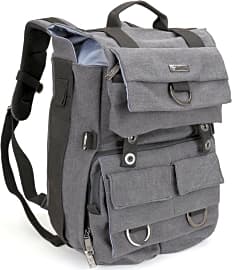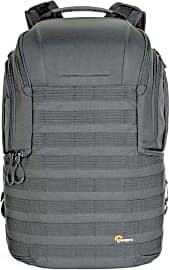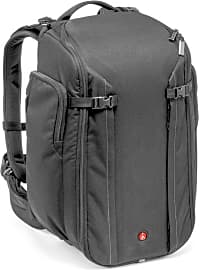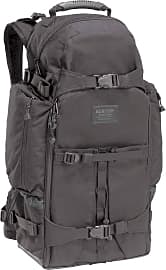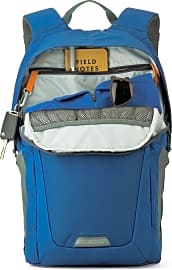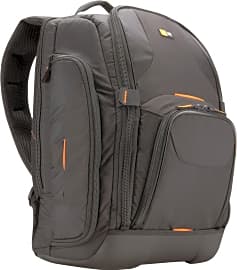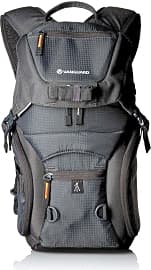The 10 Best Camera Backpacks

This wiki has been updated 35 times since it was first published in April of 2016. Whether you're traveling to parts unknown to capture images of nearly extinct wildlife or merely taking a trip across campus to photograph some unsuspecting students in their natural habitat, there's a camera backpack on our list that will hold just the right amount of gear and provide you with exactly the space and protection your equipment needs. Pick one up, pack it full, and start shooting. When users buy our independently chosen editorial picks, we may earn commissions to help fund the Wiki.
Editor's Notes
June 04, 2019:
The update to the Lowepro ProTactic BP, which was already an impressive option, was almost enough to boost it to the top of our list, but the larger laptop compartment offered by the Think Tank model that took the top spot was enough to edge it out, and the value of the Evecase Canvas allowed it to hold strong at number two. The models by Manfrotto and Burton that used to occupy the top three have each dropped a bit down to the fourth and fifth spots respectively, mostly due to being slightly outperformed by the padding and pocket organization offered by our top picks. The Vanguard Adaptor 41 slipped a spot to the bottom of our ranking, as its size can be a limiting factor for DSLR shooters with more than one big lens.
Guard Your Gear
For this reason, the camera becomes a very personal extension of our psyche.
As photographers, our gear is endlessly precious to us. Even the shooters among us who don't take very good care of their gear will often be surprisingly protective of it in transit or in the hands of others. If you look closely at it, what each of us wants much more than the camera and its lenses is the ability to shoot high quality images; images that capture our unique view of the world. If we could do it without a camera, we would, but what the camera sees is the closest representation of our singular point of view. For this reason, the camera becomes a very personal extension of our psyche.
So it wouldn't do to just strap the thing around our neck, lug an extra lens or two loose in a bag, and hope nothing bad happens. The camera backpacks on our list allow you to pack up all the necessary implements of your art without encumbering you beyond the point of shooting.
My first camera bag was a shoulder strap model that swayed and pitched with every movement of my body, taking my mind off of the task at hand. When I finally got a backpack, I was amazed at how a design that I knew to work from a dozen years of grade school could free me up to shoot with a kind of security I'd yet to experience behind the lens.
The other great thing about camera backpacks, and the backpacks on our list specifically, is their combination of size and flexibility. Even the smallest bag on our list can comfortably fit a mid-size to full-size DSLR and a pair of long lenses. The biggest can accommodate pro-level bodies and a whole outfit of lenses, as well as all the accessories you might need in the field.
Of course, no two shooters are alike, so all of these bags also have removable, interchangeable pads inside them, allowing you to customize the layout of the bag to hold whatever implements you choose to pack firmly in place.
Pack For Your Style
When I started out in photography, I cut my teeth shooting wildlife in Alaska on an entry-level DSLR with a pair of kit zooms, which are the small, inexpensive lenses that camera companies bundle with their less expensive bodies. The whole outfit could have fit in the pockets of a pair of cargo shorts.
If I had known what I was doing out there in the wilderness, I would have had better everything: a better body; better, longer lenses; a decent tripod; and a great bag. I had none of that, but to be fair, I didn't know what kind of shooter I wanted to be. I was still figuring that out.
The whole outfit could have fit in the pockets of a pair of cargo shorts.
Knowing the kinds of pictures you take, as well as the kind that you want to take, is all you need to know to make an informed choice among the camera backpacks on our list. While each could be configured for almost any kind of photography, certain features of one bag might suit it better than another for certain applications.
For example, a few years down the line I started shooting weddings. Everything we did was handheld, as the brand my friends and I had established was a journalistic, fly-on-the-wall style. A hair of motion blur here or there could actually enhance the effect of one of our images. For predominantly handheld shooters of any subject, a bag with a tripod loop designed to carry your sticks around for you isn't all that useful.
On the other hand, if I had been a more seasoned photographer in my days in the frozen north, I would have definitely wanted a tripod and a bag to which I could strap it.
Your shooting style will also help determine the size of the bag you want. For a year living in West Philadelphia, I sat around listening to a police scanner and jumped on my bicycle any time there was a violent crime within a mile of my house. I'd hop on the bike and head to the scene, then try to sell the shots to any newspaper or website that I could. For that task, I needed a lightweight bag that could hold a few items; nothing too crazy.
Take a good look at your style, your usual subject matter, and your ambitions (both in your work and in the acquisition of gear), and you ought to be able to find a bag on this list that works and looks fantastic.
Sized To Carry
In the early days of photography, equipment was a heck of a lot larger than it is today. Daguerreotypes and similar photographic methods required large exposure plates that created direct transfers onto other materials for prints at a 1:1 size ratio.
In the early days of photography, equipment was a heck of a lot larger than it is today.
Photographers transported the cameras used for this and later large format film photography in large trunks that usually also held a wooden tripod modeled after the tripods used by land surveyors. They could also contain flash materials once that technology came about.
Once cameras got small enough and friendly enough for more shooters to perfect their skills, conflict photographers and photojournalists started to use hunting bags and fishing bags to carry their cameras in dangerous areas. These kept out most water and dust, but they were very soft and they had no internal divisions for organization or protection.
Later on, camera companies created bags and cases designed specifically for certain cameras, with specific moldings suited for the exact size and shape of a given model. When third-party manufacturers began to introduce bags that had interchangeable dividers, the rest of the industry responded in kind, creating the array of multi-purpose camera bags we have today.


